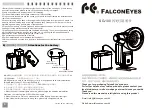
Advanced (Recording pictures)
42
VQT1C60
• Depending on the brightness and how fast
the subject is moving, jitter may not be
avoided.
• The camera may not be able to detect the
movement of the subject in the following
cases.
– When the moving subject is small
– When the moving subject is at the edge
of the screen
– When the subject starts moving the
instant the shutter button is pressed fully
• To avoid picture noise, we recommend
decreasing [ISO LIMIT] or setting
[COL.MODE] to [NATURAL]. (P63)
• The following functions cannot be used.
– [SLOW SHUTTER]
– [D.ZOOM]
Taking Close-up
Pictures
This mode allows you to take close-up
pictures of a subject, e.g. when taking
pictures of flowers. You can take pictures of
a subject as close as 5 cm from the lens by
rotating the zoom lever upmost to Wide
(1
k
).
∫
Focus range
• We recommend using a tripod and the
self-timer (P39) in macro mode.
• When a subject is close to the camera, the
effective focus range (depth of field) is
significantly narrowed. Therefore, if the
distance between the camera and the
subject is changed after focusing on the
subject, it may become difficult to focus on
it again.
• If the distance between the camera and
the subject is beyond the focus range of
the camera, the picture may not be
properly focused even if the focus
indication lights.
• Macro mode gives priority to a subject
close to the camera. Therefore, if the
distance between the camera and the
subject is more than 50 cm it takes longer
to focus on it in macro mode than normal
picture mode.
• The available flash range is about 50 cm
to 5.4 m (Wide). (When the ISO sensitivity
is set to [AUTO].)
• We recommend setting the flash to
Forced OFF [
] when you take pictures
at close range.
• When you take pictures at close range,
the resolution of the periphery of the
picture may decrease slightly. This is not a
malfunction.
5 cm
T
W
50 cm
VQT1C60ENG.book 42 ページ 2007年1月11日 木曜日 午後6時49分
Содержание Lumix DMC-LZ7
Страница 103: ...103 VQT1C60 MEMO ...
















































